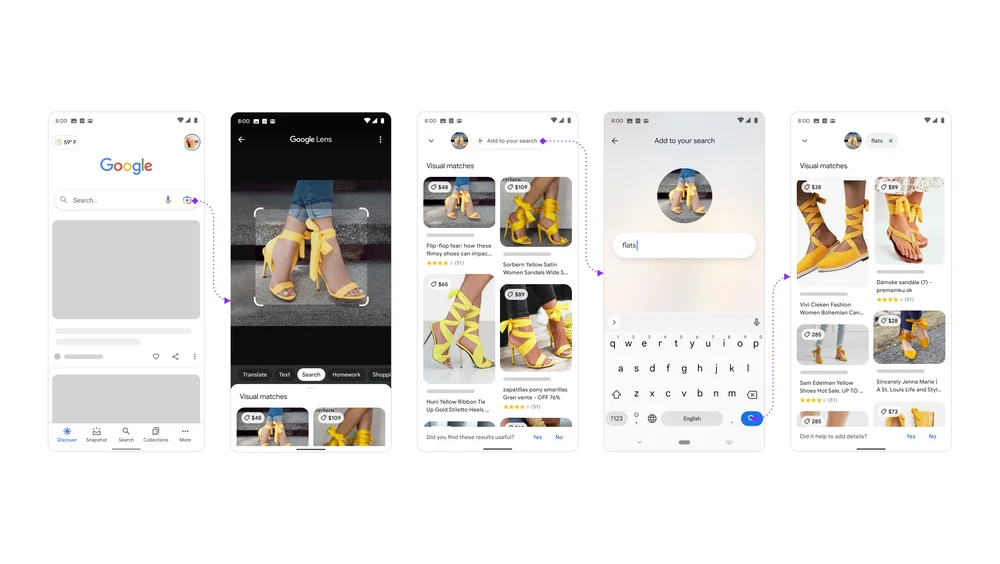AI-powered search engines are reshaping how we find information online. With tools like Google Lens, people now use photos to search for products or get details about what they see.
They need to make sure their websites and product images work well with these AI searches. To stay ahead, your website must be easy for these AI systems to read and understand. Think about clear pictures of your products that show up well in visual searches through apps like Google Lens.
Customers might snap a photo of something they like, perhaps while out shopping or from a magazine page, and use Google Lens to find similar items online.
If you’ve done it right, your products will appear in those search results. Enhancing customer experience goes beyond just having nice-looking pictures; think about all aspects, like making sure web pages load quickly on mobile devices since many users will come from there after doing an image-based search using their phones’ cameras.
Understanding Google Lens and AI-Based Visual Search
Google Lens leverages artificial intelligence to revolutionize how we search using images. It lets users snap a photo to find products, compare prices, and get shopping information instantly.
- Enhanced Search Convenience: With Google Lens, the need to type search queries is greatly reduced. Capture an image of any item you’re curious about right from your smartphone. Google Lens quickly processes this image, utilizing advanced AI algorithms. This delivers accurate details about the product, such as its brand or where you can buy it at competitive prices.
- Bridging Offline and Online Shopping: This tool blurs the lines between seeing something in real life and finding it online. Did you find something interesting while out? Just take a picture with Google Lens instead of struggling to describe it later on eCommerce sites like Amazon or platforms like Pinterest with similar features. By reducing these barriers, consumers enjoy a more fluid shopping experience across both offline moments and online searches—enhancing immediate access to product information without relying solely on text-based descriptions.
- Supporting Visual-First Users: Visual-first users who prefer images over reading detailed descriptions benefit significantly from Google Lens’ capabilities. They represent a growing segment that appreciates quick visual cues for decision-making—with clear visuals leading directly to purchase points quickly.

Why Optimizing for AI-Based Search is Crucial for Online Shops
Optimizing AI-based search engines like Google Lens is critical for the success of online shops. This ensures your products match fast-evolving shopper behaviors and preferences.
- Changing consumer behavior heavily influences shopping trends today. Shoppers value speed and convenience, favoring methods that allow them to bypass typing out long descriptions. Visual searches provide this efficiency by letting users find products through pictures rather than words. For online stores, adapting to this method means staying ahead in a competitive market.
- Enhancing user experience is another reason why optimizing for visual search matters so much. When shoppers use AI-based searches like Google Lens, they hope to conveniently locate what they need quickly. Making sure your product images are high-quality and supported with descriptive, keyword-rich texts can significantly smoothen their journey – encouraging satisfaction and return visits.
- Gaining a competitive advantage cannot be overstated; it’s essential for survival in e-commerce today. Online businesses that leverage visual search optimization early on easily distinguish themselves from competitors who have yet avoided tapping into this tech-savvy customer base—resulting in increased traffic flow and improved sales figures thanks directly or indirectly to superior SEO practices catered toward AI-driven algorithms.
How to Optimize Product Images for Google Lens and AI Search Engines
Optimizing product images for Google Lens and similar AI search engines is a game-changer. Here’s how to do it right:
- High-quality, clear images: Use only high-resolution photos for your products. Blurry or low-res pictures will confuse the AI, reducing your visibility in searches. Include shots from multiple angles to give a full view of what you’re selling. This approach helps Google Lens accurately recognize your products.
- Accurate image descriptions and alt text: Always write descriptive, keyword-rich alt text for your images. For instance, instead of just “shirt,” specify “blue cotton shirt with button-down collar.” Don’t forget about implementing Schema.org markup, too; this step makes it easier for search engines to grasp key details like price and availability.
- Contextual image relevance: The context in which you place an image matters greatly as well. Thus, we strive to position product visuals near relevant textual content on your page. Furthermore, enhancing their appeal through lifestyle imagery not only aids visual identification but also engages users more effectively during their search endeavors.
Implementing AI and Visual Search Optimization on Your Online Store
To implement AI and visual search optimization in your online store, start by using AI-powered tools like Google Cloud Vision API for image recognition. These programs can analyze product images to ensure they’re optimized for visual searches. Additionally, enabling automation within these tools helps with tagging and enhancing images consistently across the store.
Focusing on a mobile-first strategy is equally important. Make sure your website loads quickly and navigates easily on mobile devices. Since many customers use their phones for visual searches, optimizing for mobile is crucial.
Including an AI chatbot might seem advanced, but it’s effective. It guides users through image-based queries efficiently, increasing engagement and potentially boosting sales. When selecting file formats for your images, choose web-optimized options such as JPEG or WebP.
These maintain quality while ensuring fast load times, which are vital factors in both SEO rankings and user experience. Utilize tools like TinyPNG to reduce the size of image files significantly without losing quality. This improves site speed and enhances overall performance, which affects search engine rankings, including AI-based ones like Google Lens.
AI-Based Visual Search Beyond Product Images
AI-based visual search goes far beyond basic product images, transforming how customers find and interact with your online shop. By leveraging AI technologies, you can significantly boost the visibility of your products.
- Social Media Integration: Encourage sharing on platforms like Instagram to extend reach. When users share product images, AI tools may link back to your store. This connection increases the chances that those items appear in visual searches elsewhere. It’s a simple yet effective way to gain more exposure.
- User-Generated Content: Ask customers to post their own photos using your products. These real-life images offer authenticity that resonates well with potential buyers browsing through Google Lens or similar engines. Linking these user-generated pictures back gains added SEO value. Furthermore, this content often carries more trustworthiness among viewers than traditional marketing materials do.
- Videos for Product Demonstrations: Start creating videos showcasing what you sell. Engines now index videos, too. This makes them as searchable as photographs. Be sure descriptions, tags, and transcripts are detailed. These elements help AI understand and categorize content correctly, resulting in higher rankings within search results. By incorporating visuals strategically, you enhance both discoverability and appeal.
Measuring Success: Tracking Visual Search Impact on SEO
To accurately measure the success of visual search optimization for your online shop, especially when focusing on Google Lens and similar AI-based search engines, rely heavily on analytics tools. Google Analytics and Search Console are your best bets here. Through these platforms, track how much traffic arrives via visual searches.
Focus particularly on metrics like image clicks—this tells you if users find your images compelling enough to engage with them. Pay attention also to conversion rates from those clicks; it’s vital to understand not just if people interact with your photos but whether such interaction leads to an action you value (like a purchase). Observing time spent on product pages after a click can offer insights into user interest level or content effectiveness.
Use A/B testing as a tool to fine-tune these outcomes continuously. Experimenting with different image qualities, detailed descriptions adjacent to images, or strategizing alt texts more effectively can lead directly toward enhancing visibility in AI-driven visual searches. Adjust based on direct feedback from these tests: Shift strategies upon discovering specific alterations that lead towards improved performance according to specifically measured metrics.
The iterative process of refinement is crucial. Making small adjustments over time in reaction to concrete data points will refine audience engagement tactics for maximizing returns from visual search capabilities like Google Lens.
Embracing AI-Powered Visual Search for E-Commerce Success
In wrapping up our discussion on optimizing online shops for AI-powered visual search, such as Google Lens, it is clear this technology marks a significant shift in consumer behavior and e-commerce strategy. By focusing on specific optimization tactics, you can significantly enhance your store’s visibility and user experience.
- Optimize Product Images: High-quality images are crucial. They need to be crisp, well-lit, and from multiple angles to accurately match what customers might seek through visual search tools like Google Lens. Including diverse images not only improves accessibility for these searches but also boosts the likelihood of matching with consumers’ photos or screenshots looking for products similar to yours.
- Refine Product Descriptions: Use precise language that includes relevant keywords without compromising the natural flow of text; this practice helps AI understand and categorize your offerings more effectively. Remembering details users may search visually—like color names rather than just showing swatches—can make descriptions both SEO-friendly and useful for shoppers using image-driven queries.
- Enhance User Experience: A streamlined site layout facilitates easy navigation by humans and AI alike—a critical consideration since poor design discourages engagement regardless of how good your product pictures are or how optimized descriptions might be. Make checkout processes simple yet secure while ensuring pages load quickly across devices, thus reducing bounce rates, which positively impacts SEO rank indirectly, Influencing visibility via platforms employing visual searching capabilities. These strategies emphasize staying ahead in a marketplace increasingly dictated by technological advancements like artificial intelligence-infused visual searches.








